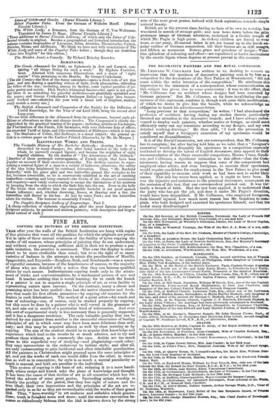FINE ARTS.
COPYING OLD PICTURES AT THE BRITISH INSTITUTION.
YILL11 after year the walls of the British Institution are hung with copies of fine pictures that want all the qualities for which the originals are prized. Yet in spite of these annual evidences of the futility of tyros copying the works of old masters, whose principles of painting they do not understand, and without even possessing sufficient ',kill in their art to produce a pas- sable imitation, the practice is continued. This year the display is consi- dered to be more creditable than usual; but to us the sight of so many varieties of badness in the attempts to mimic the peculiarities of Murillo, Spagnoletto, and Reynolds—Berghem, Both, and Rembrandt—was a source of regretful concern, because of the hopelessness of success, to the majority of those who are deluded with a notion that they can become qualified artists by such means. Indiscriminate copying tends only to the attain- ment of tricks and conventionalities, by a mechanical process of eye and hand. It teaches nothing that is worth learning; for to catch the knack of a painter is not to acquire a single principle of art, or even facility in representing nature upon canvass. On the contrary, many a clever and promising artist has been spoiled—has lost the native character and fresh- ness that made his first efforts attractive—by copying old masters for the dealers in such fabrications. The method of a great artist—his touch and tone of colouring—can, of course, only be studied properly by copying; but this must be done by a painter who is well versed in the grammar of art, and sets out in search of a particular kind of information. And even this sort of experimental study is less necessary than is generally supposed; and it has a dangerous tendency. The only valuable quality that can be derived by one painter from another is the successful observance of leading Principles of art in which some may have been more felicitous than ordi- nary; and this may be acquired almost as well by close scrutiny as by copying. The aim of the student should be to acquire that knowledge and experience which lead to the results he so much admires, not to try and produce them without, as is commonly the case. Artists are too much given to this superficial way of studying—and plagiarizing—each other: they copy mannerisms in the endeavour to imitate style; and after all, are only endeavouring to gain incidental and often inimitable peculiarities. All the painters in Christendom might proceed upon the same principles of art, and yet the works of each one would differ from the other, in execu- tion as well as in conception; for style is as much a mental peculiarity as touch is manual, and both are peculiar to the individual.
This system of copying is the bane of art; reducing it to a mere handi- craft, where recipe and knack take the place of knowledge and thought. It has been the cause of that decline of art in all countries which has fol- lowed the advent of some great genius. Succeeding artists worship so blindly the prodigy of the period, that they lose sight of nature and the true ideal; their own impressions and the principles of the art are re- garded only in so far as they are reconcileable with the works of their grand idol. Thus, "hero-worship" in art enslaves and enfeebles whole genera- tions; truth is forsaken more and more; until the monster convention be- Comes so ridiculously hideous that the idol is thrown down by the strong arm of the next great genius, imbued with fresh aspirations towards simple natural beauty.
British art at the present time, having no hero of its own to worship, has wandered in search of strange gods; and now bows down before the grim grotesque image of German adoration, enshrined in a Gothic temple of which Mr. Pugin is high priest. As rickety children are forced to wear irons, so our puny, ill-nursed babes in art, are bound up in the harsh an- gular outline of German mannerism, till their figures are as stiff, meagre, and lifeless, as mummies. Roman grace and grandeur of design—Vene- tian splendour of colouring and effect—are repudiated as harlot fascinations by the ascetic bigots whose dogmas at present prevail in this country.


























 Previous page
Previous page